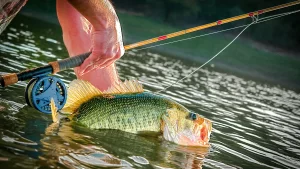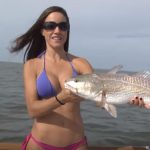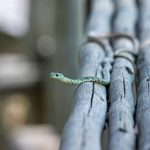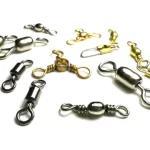As spring arrives, bass become more active, making it the perfect time for fly anglers to target them with topwater presentations. The blooming of dogwood or magnolia trees often signals the start of prime bass fishing, with post-spawn fish eager to strike surface flies.
Targeting Bass After the Spawn
Post-spawn bass are aggressive and looking to feed after expending energy during spawning. These fish readily hit surface flies that create commotion, mimicking easy prey. Observing birds, particularly red-winged blackbirds nesting in cattails, can help locate prime fishing areas, as bass may key in on fallen birds as a food source.

Essential Fly Fishing Gear for Bass
Fly Rod Selection
A 7 or 8-weight fly rod is ideal for bass fishing, offering the strength needed to cast large, air-resistant poppers while providing enough backbone to pull fish from heavy cover. A moderately priced rod, such as those from Redington, balances quality and affordability. Versatile rods that can also be used for saltwater species like redfish or striped bass offer additional value.
Fly Reel Considerations
High-end reels with advanced drag systems are unnecessary for bass fishing. Largemouth bass fight hard but don’t make long, fast runs. A reliable, budget-friendly option like the Pflueger Medalist is well-suited for the task.
Fly Line and Leader Setup
A weight-forward bass-specific fly line, such as the Scientific Anglers Mastery Bass Bug line, helps turn over large flies with ease. Leaders should be kept simple—7 feet of 20-pound test monofilament is sufficient. A shorter, stronger leader helps control big fish in thick cover and allows for aggressive presentations.
Best Bass Flies for Spring Fishing
Bass aren’t overly selective about color and design, but the movement and disturbance created by a fly can trigger strikes. Here are some of the most effective topwater fly patterns:
- Diver Flies: These patterns dive briefly before resurfacing, creating an enticing action that mimics struggling prey.
- Popping Bugs: With a concave face, these flies create loud surface disturbances, drawing bass from cover. A slow, noisy retrieve is often the key to success.
- Frog Patterns: A versatile option for fishing around lily pads, frog imitations can be worked effectively with a fly rod, offering the advantage of precise casts and minimal drag through vegetation.
- Simple Patterns: Basic poppers like Tap’s Bug remain effective, as long as the retrieve gives the fly a lifelike appearance.
The Best Time for Spring Bass Fly Fishing
Springtime presents one of the best opportunities to catch bass on the fly, as post-spawn fish are actively feeding. While expensive or technical gear isn’t necessary, using a well-matched rod, line, and leader can make casting and landing fish easier. Timing the trip with warming water temperatures and blooming vegetation can lead to unforgettable days on the water, reinforcing the seasonal rhythm of bass fishing year after year.
Image/Source: SI





